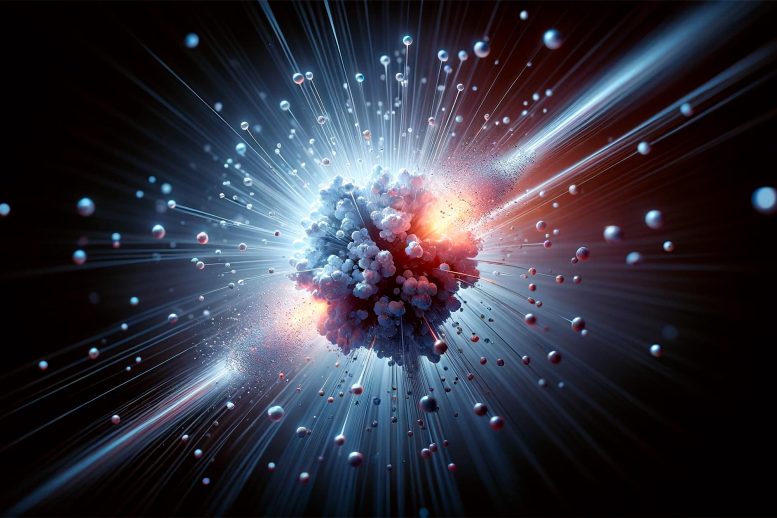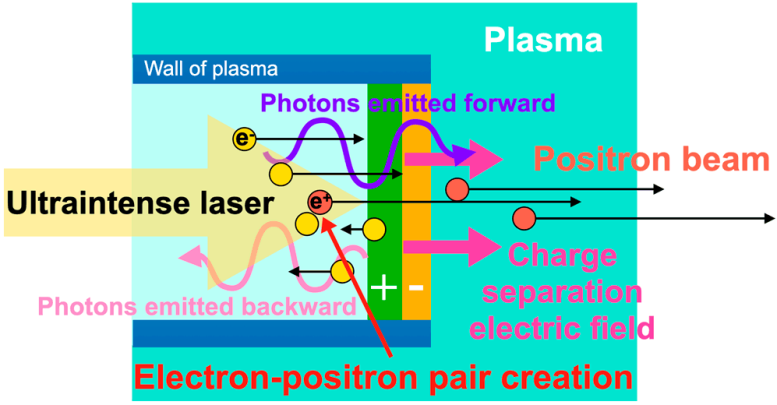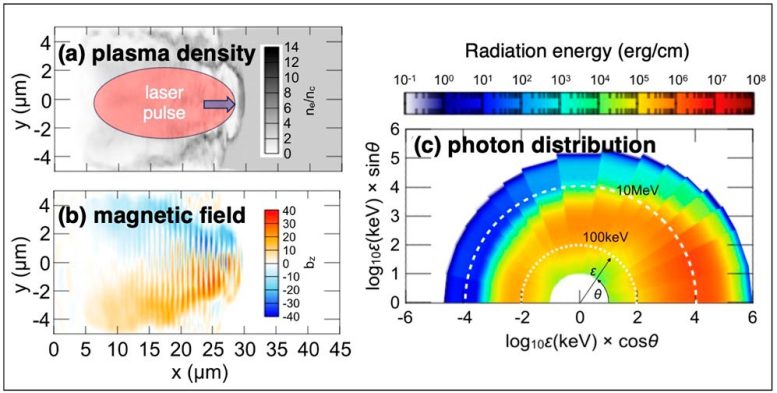
A team led by researchers at Osaka University and UC, San Diego has used simulations to demonstrate how one can experimentally produce matter solely from light, which in the future might help test long-standing theories on the composition of the universe.
One of the most striking predictions of quantum physics is that matter can be generated solely from light (i.e., photons), and in fact, the astronomical bodies known as pulsars achieve this feat. Directly generating matter in this manner has not been achieved in a laboratory, but it would enable further testing of the theories of basic quantum physics and the fundamental composition of the universe.
In a study recently published in Physical Review Letters, a team led by researchers at Osaka University has simulated conditions that enable photon–photon collisions, solely by using lasers. The simplicity of the setup and ease of implementation at presently available laser intensities make it a promising candidate for near-future experimental implementation.

Photon–photon collision is theorized to be a fundamental means by which matter is generated in the universe, and it arises from Einstein’s well-known equation E=mc2. In fact, researchers have indirectly produced matter from light: by high-speed acceleration of metal ions such as gold into one another. At such high speeds, each ion is surrounded by photons, and upon grazing past each other, matter and antimatter are produced.
However, it is challenging to produce matter experimentally in modern laboratories through the sole use of laser light because of the extremely high-power lasers required. Simulating how this feat might be achieved in a laboratory could bring about an experimental breakthrough, so that’s what the researchers set out to do.
“Our simulations demonstrate that, when interacting with the intense electromagnetic fields of the laser, dense plasma can self-organize to form a photon–photon collider,” explains Dr. Sugimoto, lead author of the study. “This collider contains a dense population of gamma rays, ten times denser than the density of electrons in the plasma and whose energy is a million times greater than the energy of the photons in the laser.”

Photon–photon collisions in the collider produce electron–positron pairs, and the positrons are accelerated by a plasma electric field created by the laser. This results in a positron beam.
“This is the first simulation of accelerating positrons from the linear Breit–Wheeler process under relativistic conditions,” says Prof Arefiev, co-author of UCSD. “We feel that our proposal is experimentally feasible, and we look forward to real-world implementation.” Dr Vyacheslav Lukin, a program director at the US National Science Foundation which supported the work, says “This research shows a potential way to explore the mysteries of the universe in a laboratory setting. The future possibilities at today’s and tomorrow’s high-power laser facilities just became even more intriguing.”
Applications of this work to the fictional matter–energy conversion technology of Star Trek remain just that: fiction. Nevertheless, this work has the potential to help experimentally confirm theories of the composition of the universe, or perhaps even help discover previously unknown physics.
Reference: “Positron Generation and Acceleration in a Self-Organized Photon Collider Enabled by an Ultraintense Laser Pulse” by K. Sugimoto, Y. He, N. Iwata, I-L. Yeh, K. Tangtartharakul, A. Arefiev and Y. Sentoku, 9 August 2023, Physical Review Letters.
DOI: 10.1103/PhysRevLett.131.065102
8 Comments
Physical Review Letters (PRL) firmly believes that two objects (such as two sets of cobalt-60) rotating in opposite directions can form a mirror image of each other. This is a typical pseudoscientific idea. Your article has been published in such a journal, there’s really nothing to show off about.
E = mc×c is good and can only be defined by quantum gravity,when associated with GR for real shape of the universe where DM/DE is included considering the rotation of galaxy.But,untill this point more extensive form of gravity as Star Dynamic Gravitational Constant G* due to rotation, approximately equal to Universal Gravitational Constant G is used.G* value is fond out
from the assembly of GR in typical form with Thermodynamic-Quantum Mechanic Relationship(
vide. also LHC experiment on Quark-Gluon
plasma). Howevver,the practical problem present now is to observe such a vast universe starting right from the milky way.
Interesting. Not a new concept. I think the Russians simulated it first. Nevertheless simulation is not science. If they cannot do it, as Mr. Huang said above it remains a pseudoscience. It needs empirical observation. The problem starts by treating the photon as a particle. Let’s see if they can overcome the hurdle that it is NOT and never was.
Achieving this physically, I believe will put the big bang theory to test and reduce the difference between particle and wave to simply a matter of behavior
Would one need the “Big Bang” to start a universe?
There is a matter creation experimental diagram at PhotonStructure.com and related particle-wave articles at the FB group: Photon Structure.
Try this equation, E=mc squared Pi
(+,-) Electron-Positron pair-formation of 1.0216 Mev “threshold” gammarays is the energy where the photon’s internal dynamics becomes unstable,after reaching an impass as the rotational radius decreases with increasing energy, which when properly stimulated, can split into a free electron and a free positron. This is the mechanism for beta-decay in proton creation, as well. And the two (+,-) muons comprising mesons, being unstable for their full spectrum, exhibit tantalizing clues to the binary photon structure of opposite charges, and the high energy limit for the e-m spectrum.